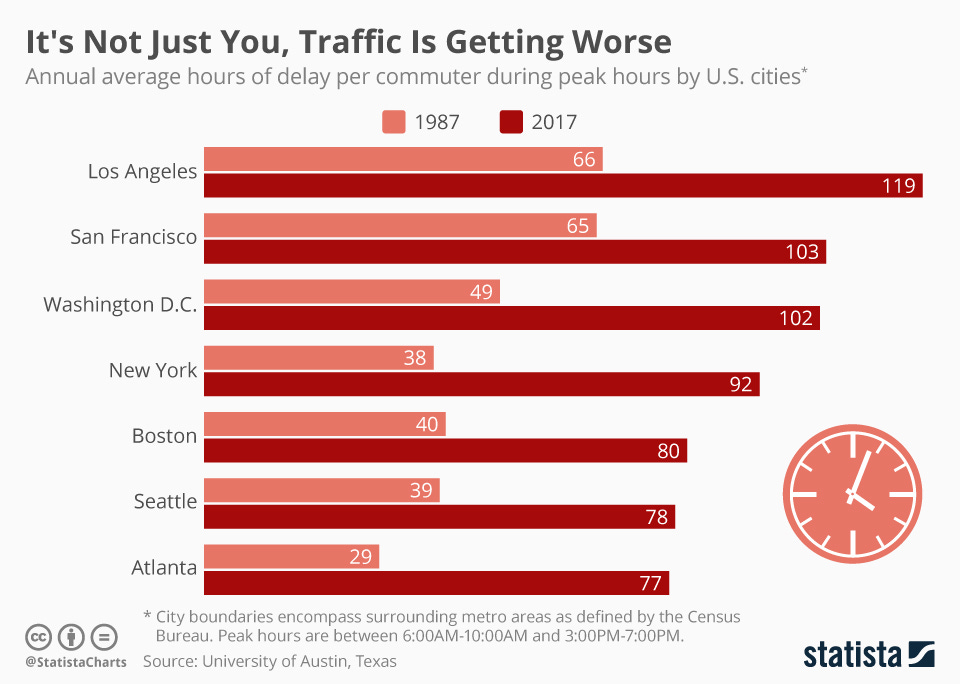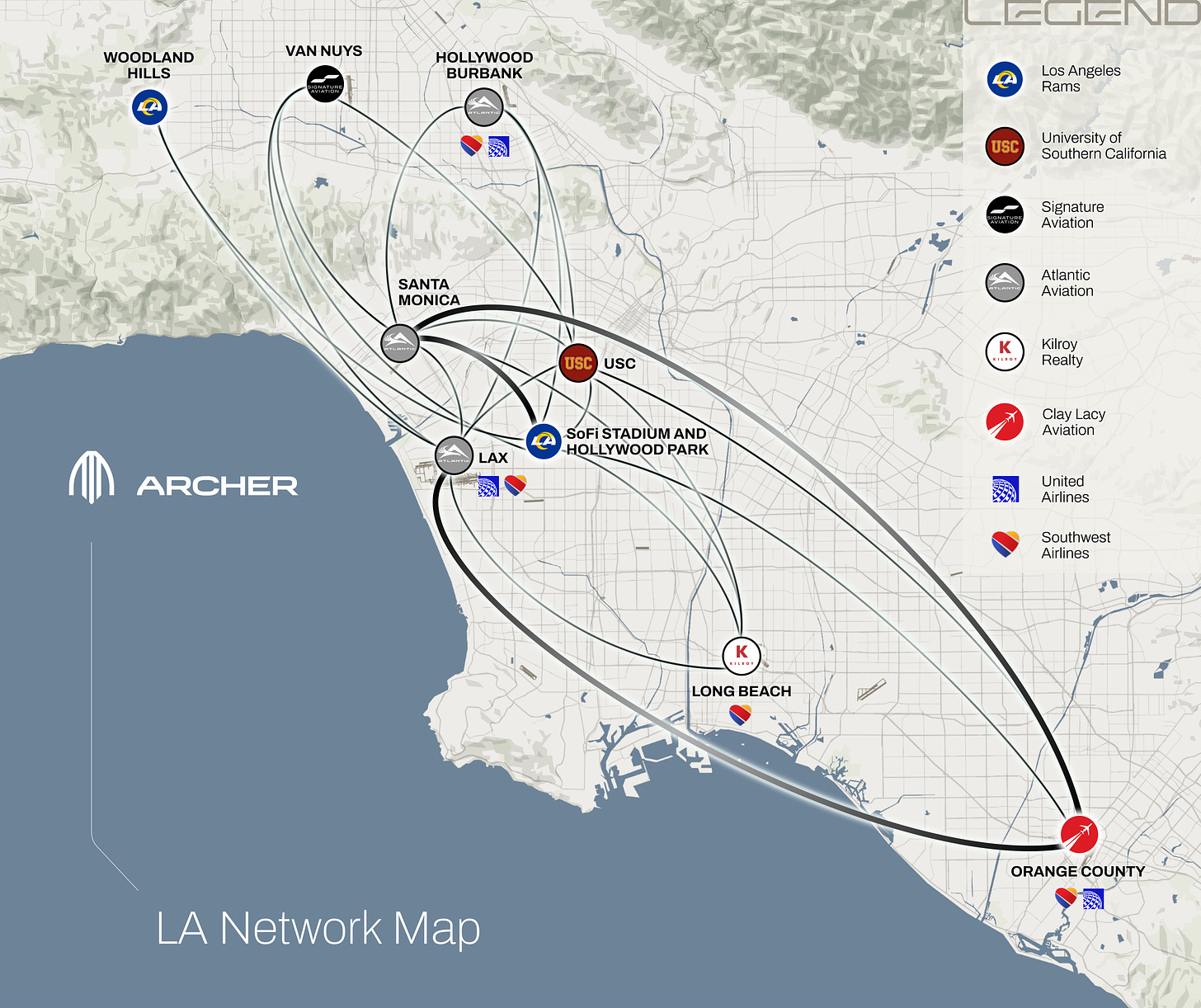Flightlines 14: Advanced Air Mobility's Emerging Impact
An innovative field reshaping urban mobility and aviation's future.
070000Z OCT 24
Good morning,
Welcome to another issue of Flightlines—
In this issue, we delve into the world of Advanced Air Mobility (AAM) and its evolving role within commercial aviation. We’ll explore AAM in its broadest sense—covering both autonomous and human-piloted aircraft—to provide a comprehensive overview of where this technology stands today. AAM holds the promise of revolutionizing short-haul transportation networks, with the potential to create an entirely new market segment in the aviation industry.
We'll also examine the leading manufacturers of electric vertical take-off and landing (eVTOL) aircraft in this emerging sector, offering a brief comparative analysis of which companies seem best positioned to make a significant impact on the future of consumer travel.
In this issue of Flightlines:
✈️ Feature: Advanced Air Mobility's Emerging Impact
📍Routes of note
Qatar Airways is launching a new route from Toronto to Doha in December 2024.
Aer Lingus will begin service from Dublin to Nashville in April 2025.
Emirates is resuming A380 service from Dubai to Prague in December 2024.
Hainan Airlines is restarting service from Xi'an to Paris in the Northern Winter 2024 season.
🗞️ In the news
Spirit Airlines considers bankruptcy filing due to ongoing financial challenges, including a failed merger with JetBlue.
Southwest Airlines announces major changes, including the introduction of assigned seating and a revamped boarding process.
Delta Air Lines expands Atlanta hub with its largest-ever summer schedule for 2025, offering 1.1 million weekly seats.
Feature
Advanced Air Mobility's Emerging Impact
Advanced Air Mobility (AAM) is a new concept in air transportation that aims to transform how goods and passengers are transported, particularly over short distances. The term broadly encompasses the development and use of new aircraft, like electric vertical take-off and landing (eVTOL) vehicles.
These aircraft can be autonomous or human piloted and are intended to improve regional connectivity, reduce travel times, and create new markets within the aviation industry.
A real-world example can be found in Los Angeles, where the city has partnered with Archer Aviation, a top eVTOL manufacturer, to integrate aerial ride-sharing services into their transportation infrastructure.

Los Angeles is notorious for its traffic congestion, often ranked among the worst in the United States. Archer aims to change that, with plans to launch its urban air mobility network as early as 2026.
Archer’s network will include “vertiports” at key locations such as Los Angeles International Airport (LAX), University of Southern California, Hollywood Burbank Airport (BUR), Orange County, and Long Beach. By building this infrastructure, Archer hopes to ease traffic woes while offering a faster, more sustainable way to travel across the city.
This initiative, launched in anticipation of major upcoming global events in Los Angeles, highlights the potential of AAM to reshape urban transportation. By offering faster, cleaner alternatives, AAM aims to alleviate congestion and redefine how people navigate crowded cites.
Improving environmental impact is a key component of the promise of AAM. With the potential for zero direct emissions from electric aircraft, AAM also presents an opportunity for more sustainable air travel, particularly over short distances. In addition to reducing emissions, AAM aircraft are being engineered with noise reduction in mind, addressing a long-standing issue when flying around populated areas.
Realizing these opportunities, however, requires overcoming considerable challenges. Regulatory frameworks must evolve to support new aircraft types. Gaining public acceptance is also critical, especially concerning safety and the impact on communities.
Meanwhile, infrastructure—ranging from vertiports to advanced air traffic management systems—also needs to develop alongside aircraft technology. The future of the AAM sector depends on how effectively these hurdles are addressed.
Let’s take a look at the top manufacturers in the space…
Joby Aviation
Based in California, Joby Aviation is one of the leading companies in the AAM sector, focused on the Joby S4 eVTOL aircraft. They've made substantial progress in certifications, partnerships (including with Uber), and acquiring approval from regulatory bodies like the FAA.
Archer Aviation
Archer is also based in the United States and focuses on urban air mobility solutions with their eVTOL aircraft named Midnight. They've secured notable partnerships, such as with United Airlines, which has made a significant order of their aircraft.
Lilium
This German company is significant in the AAM space, developing the Lilium Jet, an eVTOL aircraft designed for both urban and regional transport. Lilium stands out with its fixed-wing design, differentiating it from many other eVTOL concepts.
https://lilium.com/
These manufacturers are notable for their advanced technology, successful fundraising, and active engagement with regulators, making them front-runners in the industry.
Beyond these three AAM manufacturers—Joby, Archer, and Lilium—several other significant players are shaping the landscape, each with a distinctive vision and expertise.
Airbus, a major force in aerospace, is advancing AAM through its CityAirbus NextGen, a fully electric, fixed-wing eVTOL designed for urban transport. This project highlights Airbus's commitment to sustainable solutions for urban air travel.
Wisk Aero, a venture of Boeing, is focusing on autonomous air taxis. Their Cora model, fully electric and pilotless, aims to provide autonomous urban and suburban aerial transport.
In the UK, Vertical Aerospace is gaining attention with its VX4 model, an electric aircraft designed to carry four passengers. Backed by partnerships with major airlines such as American Airlines and Virgin Atlantic, Vertical Aerospace is well positioned to be a leader in the market.
Analysis
Joby Aviation, Archer, and Lilium exemplify three different paths within the AAM sector, each with its unique approach and vision. Technologically, Joby and Archer's designs center around propeller-based aircraft, optimized for short, urban routes, while Lilium’s electric jet is engineered for higher speeds and extended distances.
Their market strategies also diverge: Joby benefits from the groundwork laid by Uber Elevate, Archer is leveraging airline partnerships to fast-track integration, and Lilium is concentrating on regional networks, particularly in Europe, which suggests a distinct focus beyond urban centers.
Adding to the competition, Wisk, Airbus, and Vertical Aerospace each bring their own unique strengths. Wisk, supported by Boeing, is pursuing a bold path by attempting fully autonomous flight from the outset, which, while ambitious, might face significant regulatory hurdles but has many long-term benefits.
Airbus, with its considerable resources and expertise, is advancing the CityAirbus project, potentially accelerating both development and certification, thanks to its established aerospace experience. Vertical Aerospace, meanwhile, has attracted substantial pre-orders for the VX4 from airlines and leasing firms. This is a strong indicator of industry confidence in their approach.
All of these companies must navigate and balance technological innovation, regulatory approval, and market readiness.
Our Opinion
Joby Aviation is currently leading the charge in the AAM sector. Their progress with FAA certification, bolstered by Toyota's manufacturing expertise and the insights gained from Uber Elevate, sets them apart from competitors. Joby's technological readiness, strategic partnerships, and certification achievements provide a distinct advantage, potentially making them the first to bring eVTOL aircraft to market.
AAM is poised to reshape commercial aviation over the next 10-20 years by creating a new layer of air transportation. This emerging sector will complement existing air travel networks, filling gaps in short and medium-range routes and potentially revitalizing smaller airports while alleviating congestion at major hubs.
As AAM matures, it could drive more broad adoption of electric and autonomous technologies in larger aircraft, helping to catalyze a shift towards more efficient air travel across the entire aviation industry. As the sector rapidly evolves it stands poised to not only create a new segment within aviation but also to drive broader innovations in urban planning, providing a future where the sky is no longer the limit, but a common mode of everyday transport. ✈
Let's explore this week's noteworthy events that are shaping the future of air travel.
Routes of note
The most significant new routes and service changes this week, offering insight into strategic expansions and market shifts.
🇶🇦 Doha (DOH) – 🇨🇦 Toronto (YYZ) via Qatar Airways, December 2024
Qatar Airways' entry into the Canadian market marks a significant development, potentially disrupting Air Canada's dominance on Middle East routes from Toronto. This new service could lead to increased competition, improved connectivity between North America and the Middle East/South Asia, and possible fare reductions on these routes.🇮🇪 Dublin (DUB) – 🇺🇸 Nashville (BNA) via Aer Lingus, April 2025
Aer Lingus' new transatlantic gateway to Nashville opens up direct access to Europe for the city. This route could stimulate tourism and business ties between Ireland and the American Southeast, while also offering convenient connections to the rest of Europe through Dublin for Nashville-based travelers.🇦🇪 Dubai (DXB) – 🇨🇿 Prague (PRG) via Emirates, December 2024
The return of Emirates' A380 to this route signals a significant capacity increase and suggests strong demand recovery in the Prague-Dubai market. This could have substantial implications for tourism and business travel between Central Europe and the Middle East, as well as for connecting traffic to Asia and Australia via Dubai.🇨🇳 Xi'an (XIY) – 🇫🇷 Paris (CDG) via Hainan Airlines, NW24
Hainan Airlines' revival of this route is noteworthy as it represents a direct long-haul connection between a major Chinese secondary city and Europe. It could indicate growing confidence in the recovery of China-Europe travel demand and potentially stimulate tourism and business links between central China and France.
In the news
The latest and most impactful stories shaping the world of commercial aviation this week.
SEPTEMBER 30TH, 2024
After 53 Years, Southwest Airlines Just Announced Some Big Changes, and It’s Kind of Heartbreaking - Inc.
Southwest is planning significant commercial overhauls, including the introduction of assigned seating (ending their long-standing open seating policy), preferred seating options, and changes to their boarding process. This marks a major shift in the airline's business model.
OCTOBER 3RD, 2024
Spirit Airlines Explores Bankruptcy Filing - WSJ
Reports suggest Spirit Airlines is discussing a potential bankruptcy filing due to financial challenges, including unprofitable quarters and a failed merger with JetBlue. This could significantly impact the ultra-low-cost carrier market in the US.
OCTOBER 4TH, 2024
Delta at ATL: Bigger and bolder at the world’s largest airline hub in summer 2025 - Delta News Hub
Delta announced its largest-ever schedule from Atlanta for summer 2025, offering 1.1 million weekly seats and 968 daily flights. This expansion reinforces Atlanta's position as the world's largest airline hub.KLM Takes "Painful" Measures to Improve Operational and Financial Position - Airline Economics
KLM revealed plans to improve its operational and financial position, aiming to boost its operating result by €450 million. This reflects ongoing challenges in the European airline market.
OCTOBER 5TH, 2024
Frontier Airlines Airbus A321 Catches Fire Upon Landing In Las Vegas - Simple Flying
A Frontier Airlines Airbus A321 experienced a fire in its landing gear upon touching down at Las Vegas Harry Reid International Airport. The incident, captured on video and shared on social media, showed flames erupting from the aircraft's landing gear area as it rolled down the runway. Despite the alarming visuals, the plane landed safely and all passengers were evacuated without injury
✈
Thank you for reading.
Flightlines will be back next week with more insights and updates from the world of commercial aviation.
Until then, safe travels and happy flying!











Pretty amazing to me how advanced and how many players are already involved in the AAM industry. Difficult to imagine how air traffic control will evolve especially given their current challenges.